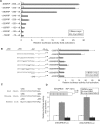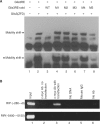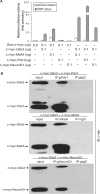The Krüppel-like zinc finger protein Glis3 directly and indirectly activates insulin gene transcription
- PMID: 19264802
- PMCID: PMC2677877
- DOI: 10.1093/nar/gkp122
The Krüppel-like zinc finger protein Glis3 directly and indirectly activates insulin gene transcription
Abstract
Glis3 is a member of the Krüppel-like family of transcription factors and is highly expressed in islet beta cells. Mutations in GLIS3 cause the syndrome of neonatal diabetes and congenital hypothyroidism (NDH). Our aim was to examine the role of Glis3 in beta cells, specifically with regard to regulation of insulin gene transcription. We demonstrate that insulin 2 (Ins2) mRNA expression in rat insulinoma 832/13 cells is markedly increased by wild-type Glis3 overexpression, but not by the NDH1 mutant. Furthermore, expression of both Ins1 and Ins2 mRNA is downregulated when Glis3 is knocked down by siRNA. Glis3 binds to the Ins2 promoter in the cell, detected by chromatin immunoprecipitation. Deletion analysis of Ins2 promoter identifies a sequence (5'-GTCCCCTGCTGTGAA-3') from -255 to -241 as the Glis3 response element and binding occur specifically via the Glis3 zinc finger region as revealed by mobility shift assays. Moreover, Glis3 physically and functionally interacts with Pdx1, MafA and NeuroD1 to modulate Ins2 promoter activity. Glis3 also may indirectly affect insulin promoter activity through upregulation of MafA and downregulation of Nkx6-1. This study uncovers a role of Glis3 for regulation of insulin gene expression and expands our understanding of its role in the beta cell.
Figures






Similar articles
-
Transcription factor GLIS3: Critical roles in thyroid hormone biosynthesis, hypothyroidism, pancreatic beta cells and diabetes.Pharmacol Ther. 2020 Nov;215:107632. doi: 10.1016/j.pharmthera.2020.107632. Epub 2020 Jul 18. Pharmacol Ther. 2020. PMID: 32693112 Free PMC article. Review.
-
Functional analysis of the zinc finger and activation domains of Glis3 and mutant Glis3(NDH1).Nucleic Acids Res. 2008 Mar;36(5):1690-702. doi: 10.1093/nar/gkn009. Epub 2008 Feb 7. Nucleic Acids Res. 2008. PMID: 18263616 Free PMC article.
-
The Krüppel-like protein Gli-similar 3 (Glis3) functions as a key regulator of insulin transcription.Mol Endocrinol. 2013 Oct;27(10):1692-705. doi: 10.1210/me.2013-1117. Epub 2013 Aug 8. Mol Endocrinol. 2013. PMID: 23927931 Free PMC article.
-
Downregulation of Glis3 in INS1 cells exposed to chronically elevated glucose contributes to glucotoxicity-associated β cell dysfunction.Islets. 2024 Dec 31;16(1):2344622. doi: 10.1080/19382014.2024.2344622. Epub 2024 Apr 23. Islets. 2024. PMID: 38652652 Free PMC article.
-
Emerging roles of GLIS3 in neonatal diabetes, type 1 and type 2 diabetes.J Mol Endocrinol. 2017 Feb;58(2):R73-R85. doi: 10.1530/JME-16-0232. Epub 2016 Nov 29. J Mol Endocrinol. 2017. PMID: 27899417 Review.
Cited by
-
GLIS3 and Thyroid: A Pleiotropic Candidate Gene for Congenital Hypothyroidism.Front Endocrinol (Lausanne). 2018 Nov 29;9:730. doi: 10.3389/fendo.2018.00730. eCollection 2018. Front Endocrinol (Lausanne). 2018. PMID: 30555422 Free PMC article.
-
GLIS1-3: Links to Primary Cilium, Reprogramming, Stem Cell Renewal, and Disease.Cells. 2022 Jun 3;11(11):1833. doi: 10.3390/cells11111833. Cells. 2022. PMID: 35681527 Free PMC article. Review.
-
Transcription factor GLIS3: Critical roles in thyroid hormone biosynthesis, hypothyroidism, pancreatic beta cells and diabetes.Pharmacol Ther. 2020 Nov;215:107632. doi: 10.1016/j.pharmthera.2020.107632. Epub 2020 Jul 18. Pharmacol Ther. 2020. PMID: 32693112 Free PMC article. Review.
-
Differential Gene Dosage Effects of Diabetes-Associated Gene GLIS3 in Pancreatic β Cell Differentiation and Function.Endocrinology. 2017 Jan 1;158(1):9-20. doi: 10.1210/en.2016-1541. Endocrinology. 2017. PMID: 27813676 Free PMC article.
-
Zinc Supplementation Improves Glucose Homeostasis in High Fat-Fed Mice by Enhancing Pancreatic β-Cell Function.Nutrients. 2017 Oct 20;9(10):1150. doi: 10.3390/nu9101150. Nutrients. 2017. PMID: 29053582 Free PMC article.
References
-
- Kim YS, Lewandoski M, Perantoni AO, Kurebayashi S, Nakanishi G, Jetten AM. Identification of Glis1, a novel Gli-related, Kruppel-like zinc finger protein containing transactivation and repressor functions. J. Biol. Chem. 2002;277:30901–30913. - PubMed
-
- Zhang F, Nakanishi G, Kurebayashi S, Yoshino K, Perantoni A, Kim YS, Jetten AM. Characterization of Glis2, a novel gene encoding a Gli-related, Kruppel-like transcription factor with transactivation and repressor functions – roles in kidney development and neurogenesis. J. Biol. Chem. 2002;277:10139–10149. - PubMed
-
- Attanasio M, Uhlenhaut NH, Sousa VH, O’Toole JF, Otto E, Anlag K, Klugmann C, Treier AC, Helou J, Sayer JA, et al. Loss of GLIS2 causes nephronophthisis in humans and mice by increased apoptosis and fibrosis. Nat. Genet. 2007;39:1018–1024. - PubMed
Publication types
MeSH terms
Substances
Grants and funding
LinkOut - more resources
Full Text Sources
Medical
Molecular Biology Databases

